The Songs That Kept Us Going This Year
Let’s be real: 2025 was not fun. Here are the tracks we turned to to help us get through the year.


Let’s be real: 2025 was not fun. Here are the tracks we turned to to help us get through the year.
Gina Cargas reached out to the community about collecting records for her middle school students. The response was overwhelming.
Dinner was pure, thoughtless dude chum.
The vibes around Ballhalla are immaculate — yet the league is still mired in misogyny and inequality. What’s a fan to do?

The WNBA’s first Bay Area franchise spectacularly exceeded expectations this summer. As the first expansion team in the league to make the playoffs during their inaugural season, the Golden State Valkyries have sold out every home game, packing Chase Center with 18,000 fans who — and this can not be overstated — are at the forefront of queerness in the WNBA.
Indeed, the Valkyries bring an even gayer crowd to a league that, after years of insisting on a regime of straightness, has recently undergone a gay transformation. As one of many queer fans who grew up in the Bay, I can tell you that our fanbase arrived hungry, surviving decades in a region where pro women’s basketball teams only went defunct (San Francisco Pioneers, 1979-81; San Jose Lasers, 1996-98; Sacramento Monarchs, 1997-2009). Even months into the Valkyries first season, generations of queers in the Bay Area remain stunned to have a WNBA team that we call our own.
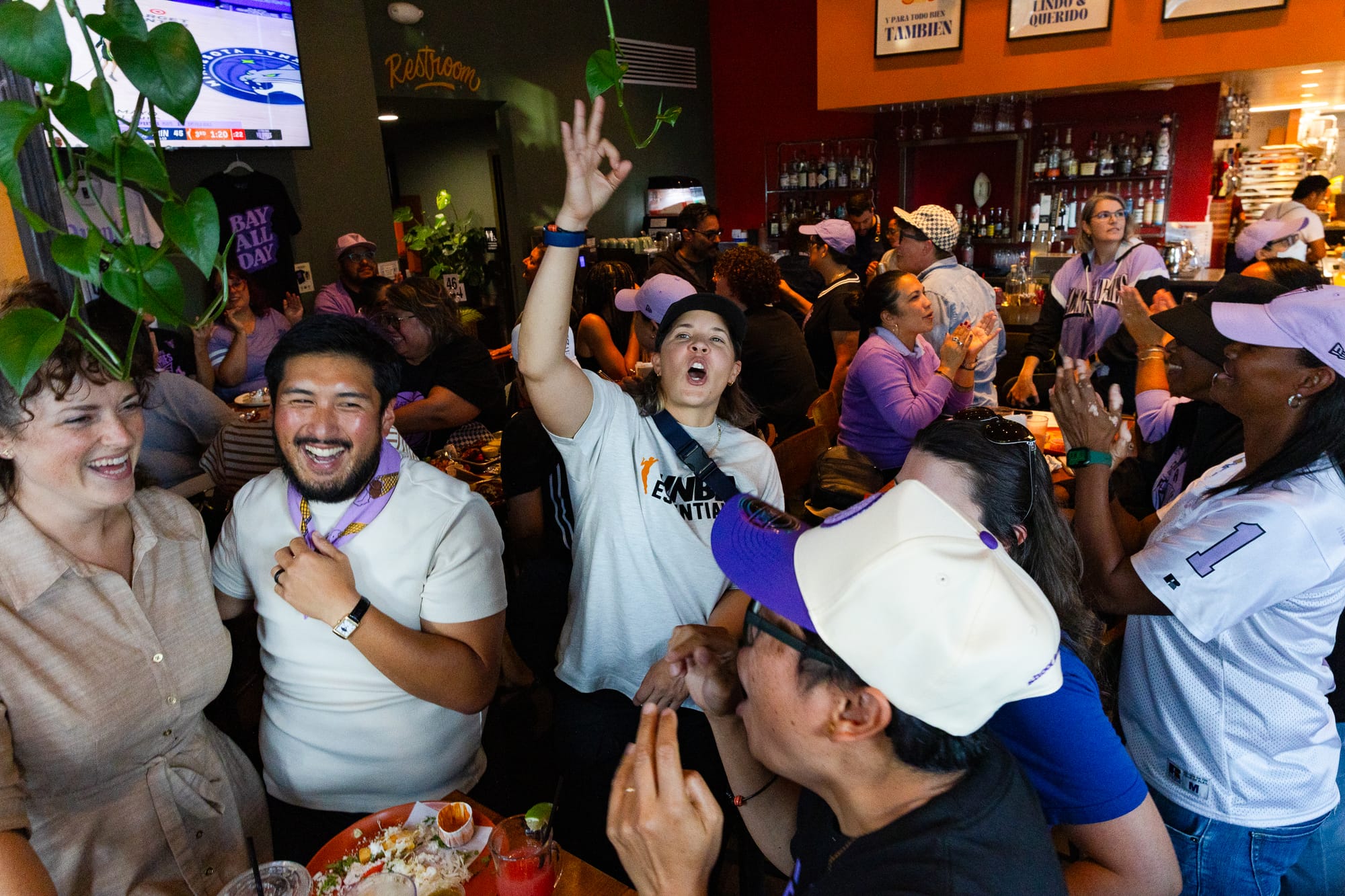
The muted colors and tech bros at Warriors games have given way to a lavender-draped world of “Ballhalla,” where our mascot is a female raven and gender-expansive couples hold hands through the crowds. Once, Angela Davis appeared before a game to bang the ceremonial drum. This spirit spills out of Chase Center, too: Exit the arena, and you’ll often find a mass of intergenerational fans outside, bouncing around a DJ booth. It’s palpable joy, pure splendor.
Alongside the Valkyries’ momentum is a sense of queer community-building — with fandom as a launching pad. Over the last few months, I’ve shared meals with other queer fans, visited folks’ homes, met their partners, stayed out too late for karaoke, played pick-up basketball, danced after hours at the White Horse, and collaborated on new creative projects.
“It feels like we should have already been connected,” my friend Rita Forte of Women’s All B-Ball out of Oakland once told me. “But now [the WNBA] is bringing us even more together.”
And yet, the Golden State Valkyries are far from being a grassroots community organization. This is the most valuable franchise in the WNBA, created by white billionaires who see women’s basketball’s potential to turn a massive profit — all while the players continue to make far less than their male counterparts.
The inequalities are staggering: While WNBA players currently receive just 9.3% of their league’s revenue, NBA players receive 49-51% from their league. Women players’ salaries are also capped at a figure that’s actually less than one-quarter of NBA players’ minimum (more on that in a bit). It’s no wonder that the Women’s National Basketball Players’ Association (the union) and the WNBA (42% of which is actually owned by the NBA) are at odds.

WNBA players have, understandably, insisted on a new contract, in response to which the league made an offering that one WNBA team union rep called “a slap in the face.” And while chants of “Pay them! Pay them!” boomed through this year’s WNBA All-Star Game, the new contract is reportedly unlikely to be signed by its deadline of Oct. 31. This would signify a devastating choice by a league that has severely undervalued its own players since its creation in 1996.
As a women’s basketball writer, I’ve long been fascinated by the paradox of the WNBA as both fertile ground for radical social change and a corporation created within the confines of, and still overwhelmingly anchored by, capitalism. And I figure I can’t be alone here, especially as the Valkyries’ success has amplified both sides of this dichotomy.
How are queer fans — lesbians, non-binary and trans folks in particular — grappling with these contradictions? What’s a radical or progressive Valkyries fan to make of all the season’s exhilarating triumphs, colliding with historic misogyny and the league’s greatest labor struggle to date?
The first time I experienced a lime green dildo being thrown at a WNBA game this season was at a “People’s Watch Party” in Oakland, surrounded by fellow queer fans. As soon as the camera caught the dildo’s shape, lying just beside the Valkyries bench, the room erupted in confused delight. But what started as a moment of surprise and laughter quickly turned darker: over the course of the next two weeks, more than half a dozen dildos were either thrown or discovered in WNBA arenas. As it turned out, this was the work of young men seeking to profit from cryptocurrency bets, a bizarre twist that you can read about here (or not).

I had a strange experience with “Dildo-Gate,” as it became known. Of course I recognized the violence of interrupting women’s labor with the intrusion of a sex toy, the clear embodiment of rape culture. But at the same time, it didn’t surprise me at all; women’s basketball has always been known for breaking traditional norms of gender and sexuality, which often sparks disdain, if not fury, from men. WNBA fandom has not rid itself of undercurrents of misogyny — or, for that matter, racism. Cue, for example, the reality of racial bias infused into the contrived controversy between Caitlin Clark and Angel Reese, the twisted narratives casting Black WNBA stars as villains, or the MAGA-inflected obsessions surrounding white players on the Indiana Fever.
But weeks of group text threads with fellow queer fans about Dildo-Gate left me wondering about the power of WNBA fans to claim our own jokes. It’s Valkyries fans, after all, who raise our fingers to chant “V’s Up!” and make t-shirts from the official rallying cry “What a Dagger.”
Ultimately, what I took away was a provocation: what happens when queer fans re-fashion the WNBA’s historically defensive stance into our own? How might the arrival of so many lesbians insist on a new narrative completely?
One of my favorite places to watch the Valkyries this summer is a classic sports bar near my parents’ house in Oakland, where the carpet is synonymous with “funky odor” and you can’t tell the bartenders and regulars apart. George & Walt’s has been open for over 75 years, currently owned by a woman named Barb (who is indeed related to both George and Walt). Barb is enthusiastic about playing the WNBA on her many televisions: She directs bartenders to put sound on for Valkyries games and even created a drink at the beginning of the season called “the Valkyrie shot,” made with grape Kool-Aid.
It’s at an old-school sports bar like George & Walt’s that I think you can see how the WNBA’s cultural imprint has shifted dramatically — it’s no longer a tired punchline. During pre-season at the bar, I met a queer fan studying their “cheat sheet” of Valkyries players — complete with their positions, alma maters, and random facts to remember them by. Another time, I partnered with a group called the ValQueeries to throw a Sunday morning watch party at George & Walt’s, and Barb opened early, bringing her chef to cook breakfast for us all. From at least a few fans, I heard a similar sentiment: “I didn’t know this bar could ever feel so queer.”
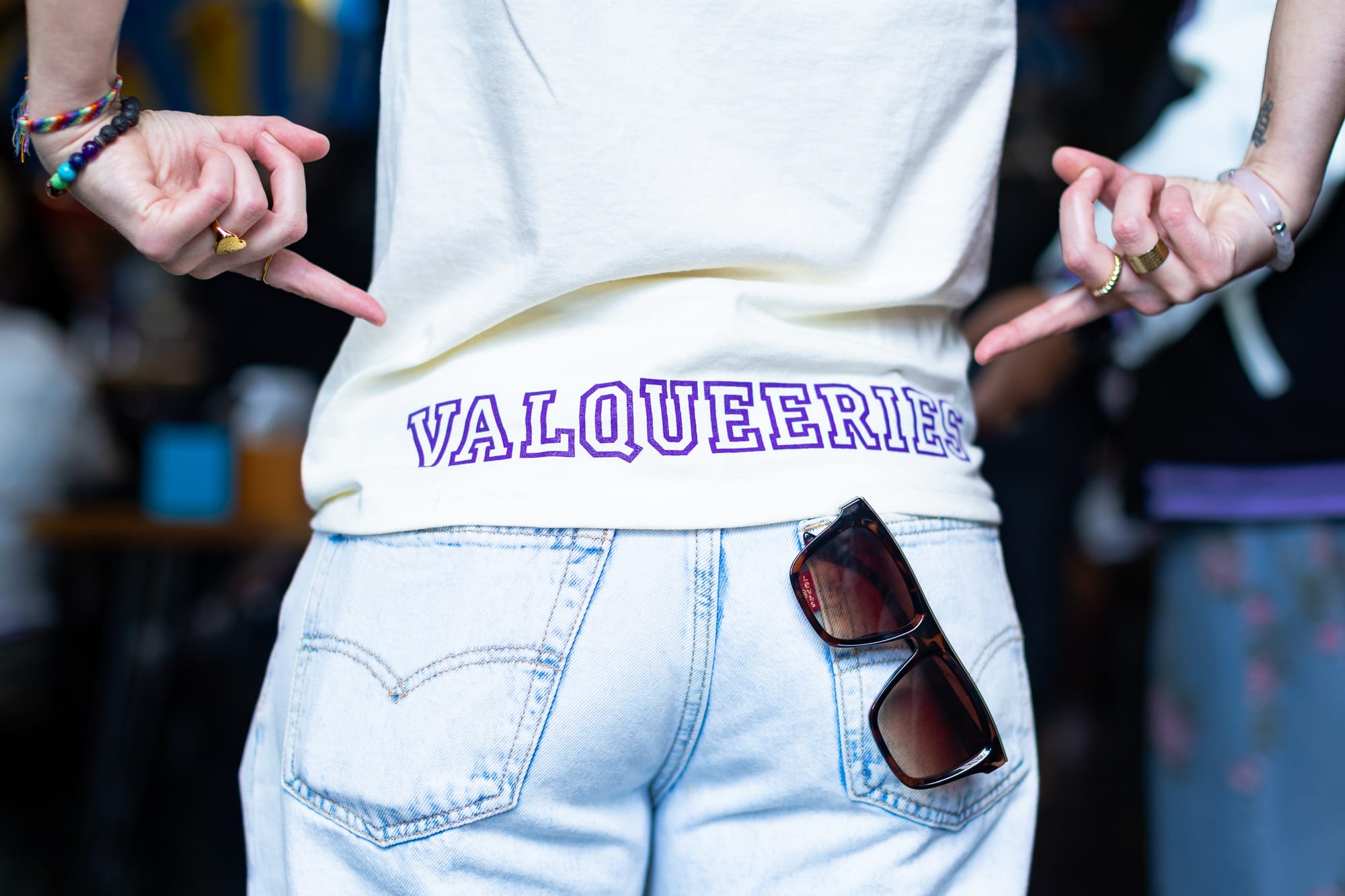
Another time, I met a guy named Marko who pulled his gray hair back in a low ponytail and told me he lives in his van nearby. Marko called himself a “lifelong sports fan.”
“I don’t drink alcohol,” he told me. “I drink excitement! And the Valkyries are becoming my team now.”
“Did you watch the WNBA before this season?” I asked him.
“No,” Marko said. “But the ladies finally got good.”
I smiled. “I don't know about that,” I said.
He looked a little embarrassed. “Well, you know, I wasn’t actually paying attention.”
The argument that the quality of women’s sports is only now high enough to deserve attention and investment is everywhere, wafting around old school sports bars and media networks and dinner tables — wherever straight men are, really. In fact, skepticism around the substance of women’s basketball has long been insidious to mainstream sports’ culture, providing a kind of cover for underfunding and disenfranchisement. With 42% of the WNBA still controlled by NBA owners, it’s men’s basketball stakeholders who historically determine the material conditions for the league.
As Suzanne Abair, the CEO of the Atlanta Dream, told economist David Berri in his book Slaying the Trolls, “If the 12 WNBA owners say they want to do something and the NBA says no, the answer is no.”
It can be difficult, in the middle of a basketball game, to find time to chat. That’s how I ended up outside the bathroom near section 109 with my friend Katie and her mom Martha, the final minutes draining from halftime. Sometimes Katie sends me videos of Martha and Sara, Katie’s other mom, dissecting WNBA players' tunnel fits and giggling over endless videos of teammates’ off-court shenanigans.
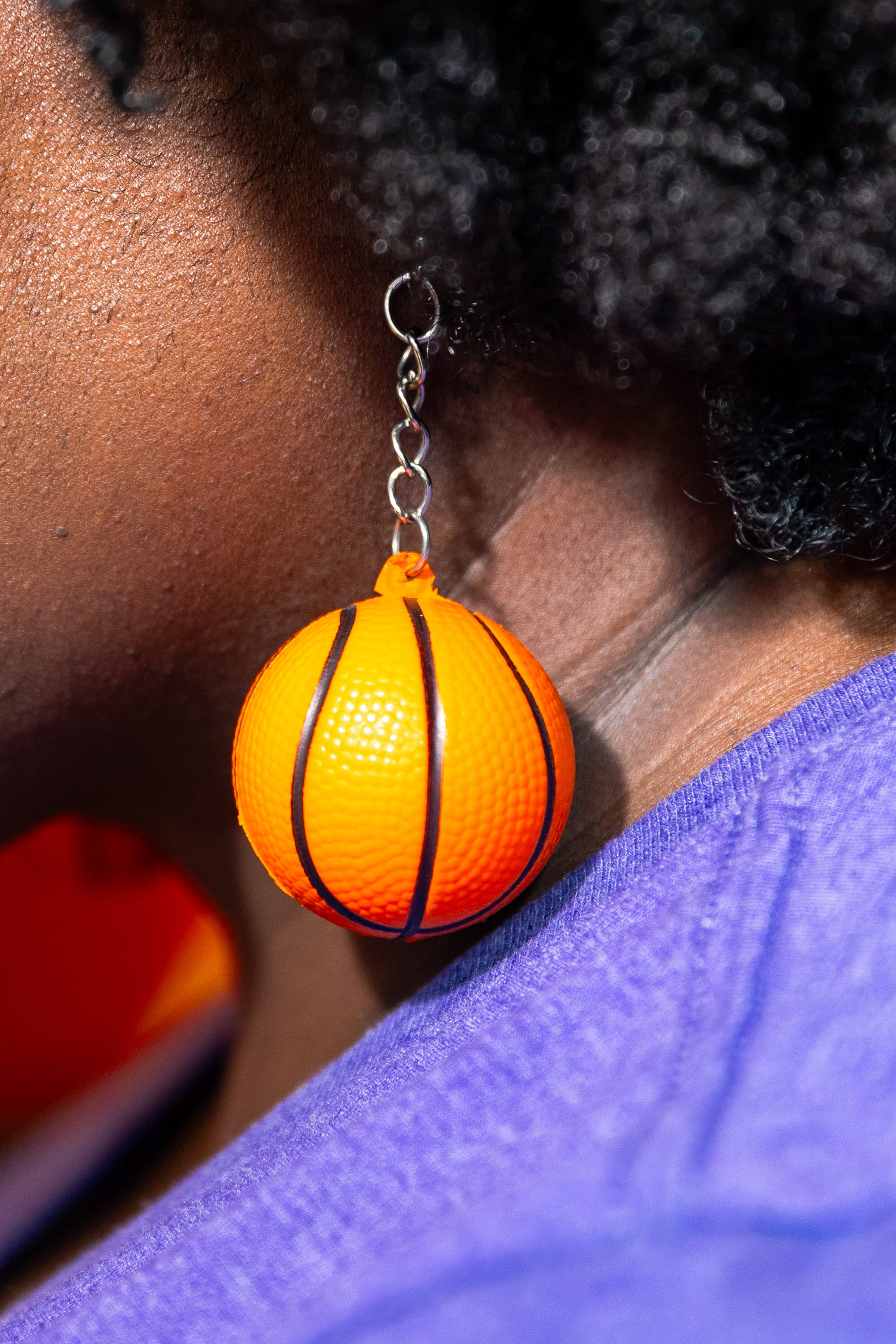

Left: Crescentia Brown, 60, from Richmond, wears custom basketball earrings. Right: Monica Leslie, 43, holds a handmade Valkyries keychain. (Estefany Gonzalez/COYOTE Media Collective)
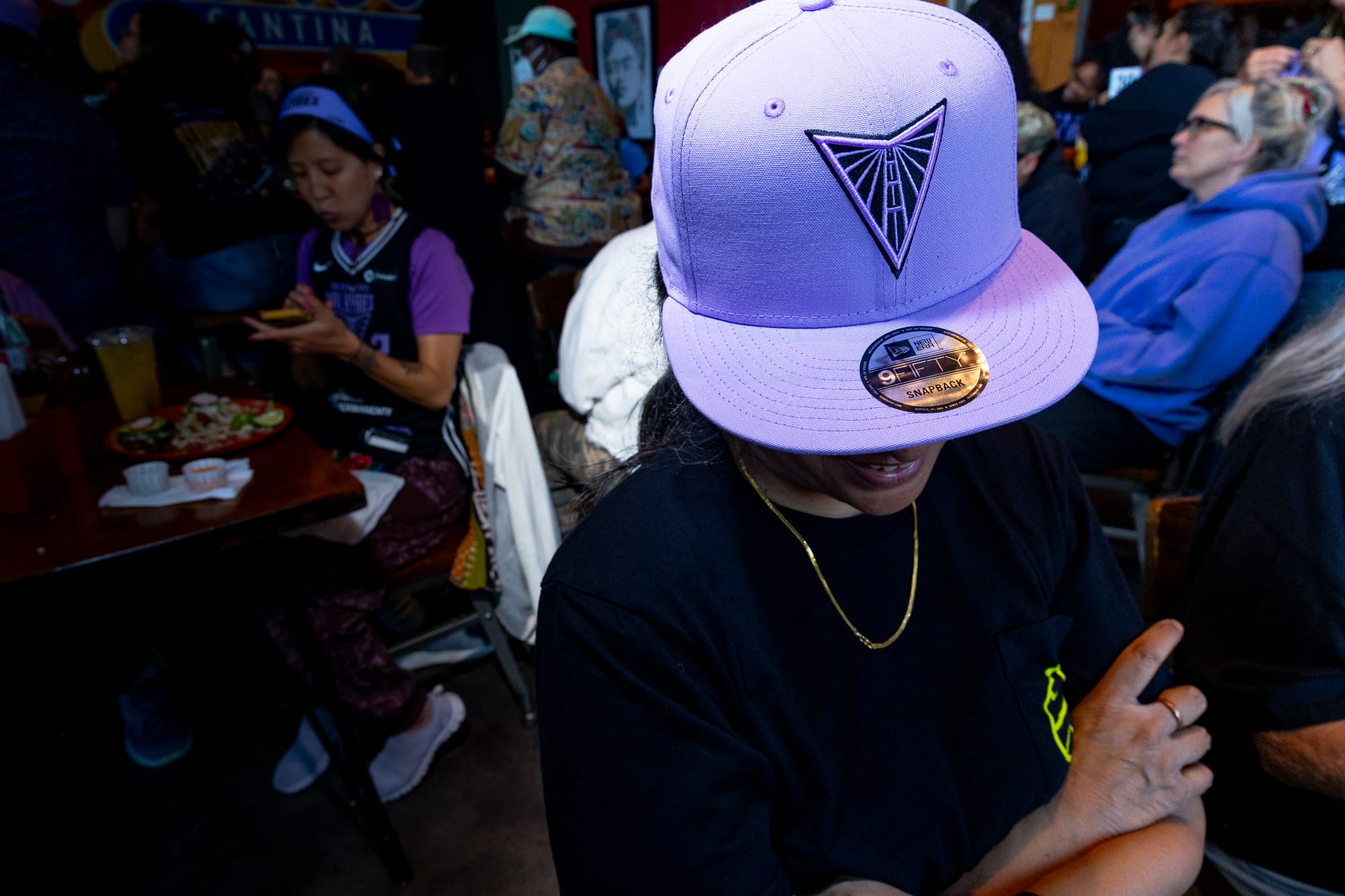
Martha made a confession: she’d bought Katie official merch for her birthday. “The allure is too great,” said Martha. Given the current labor struggle, especially, she hadn’t wanted to spend money on Golden State apparel, wary of her dollars going straight to wealthy owners’ pockets. “I had my hesitations, but then the real thing is too appealing. I threw away all my principles,” she said. “When you’re in Ballhalla, dykes are the stars. It’s intoxicating.”
Martha, like many Valkyries fans, has never before been a season ticket holder to any professional sport (though she did win Most Improved Player on the Barnard Bears women’s basketball team in 1986). At another game, I met a fan named Cindy from Walnut Creek, who told me that she drew down on her retirement to purchase three Valkyries season tickets. “And it was worth it!” she exclaimed.
Indeed, queer Valkyries fans are often defined not by their past proximity to professional sports, but by the power of their appearance now.
“This is what cracks me up about the Valkyries,” community organizer and educator Carolyn Sideco told me recently. “Only 7% of their season ticket holders come from the Warriors. So they brag about how [that shows] they're reaching out to different communities… [how] there are people who've never been to the Chase Center except because of the Valkyries, right?”
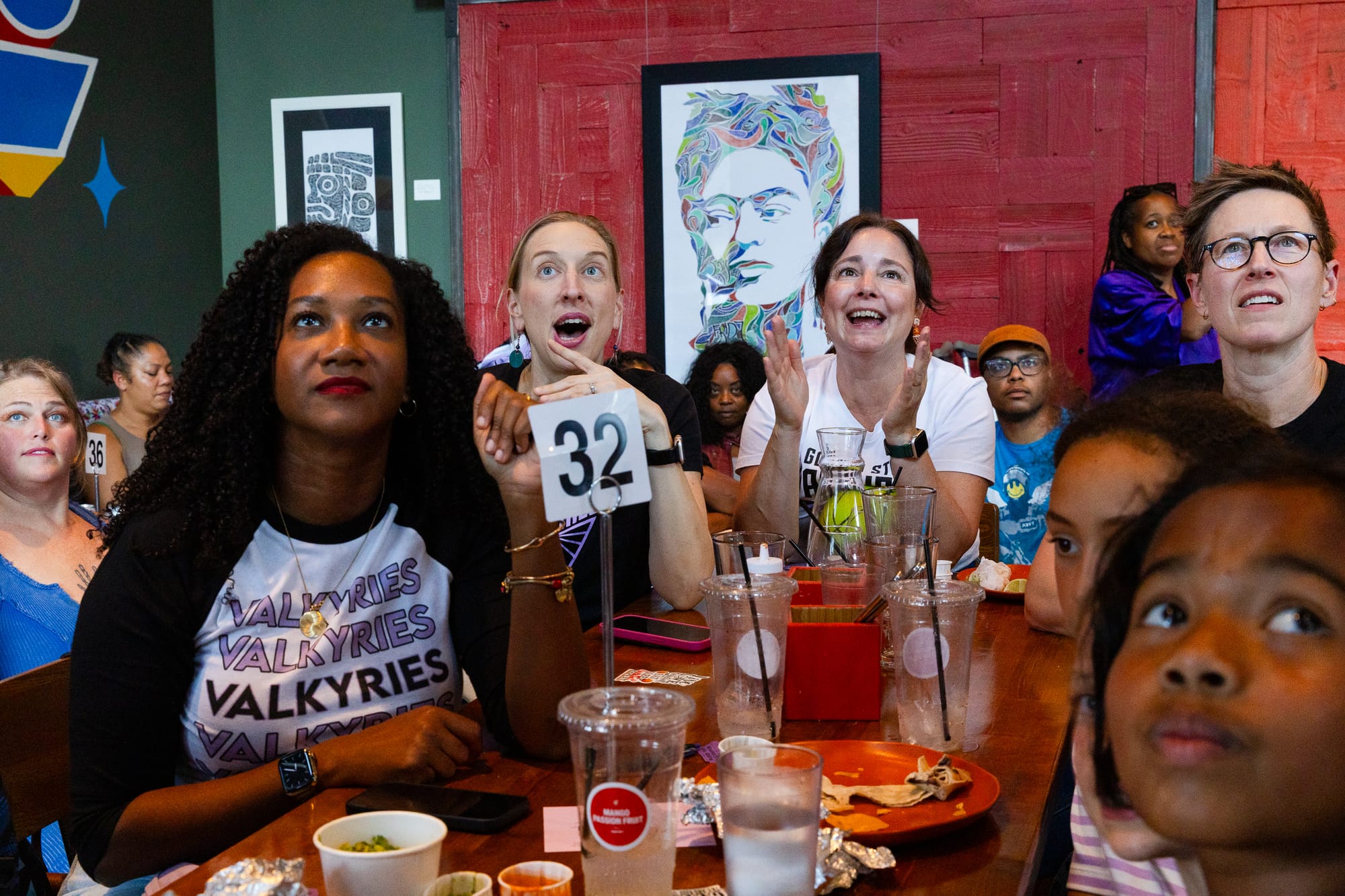
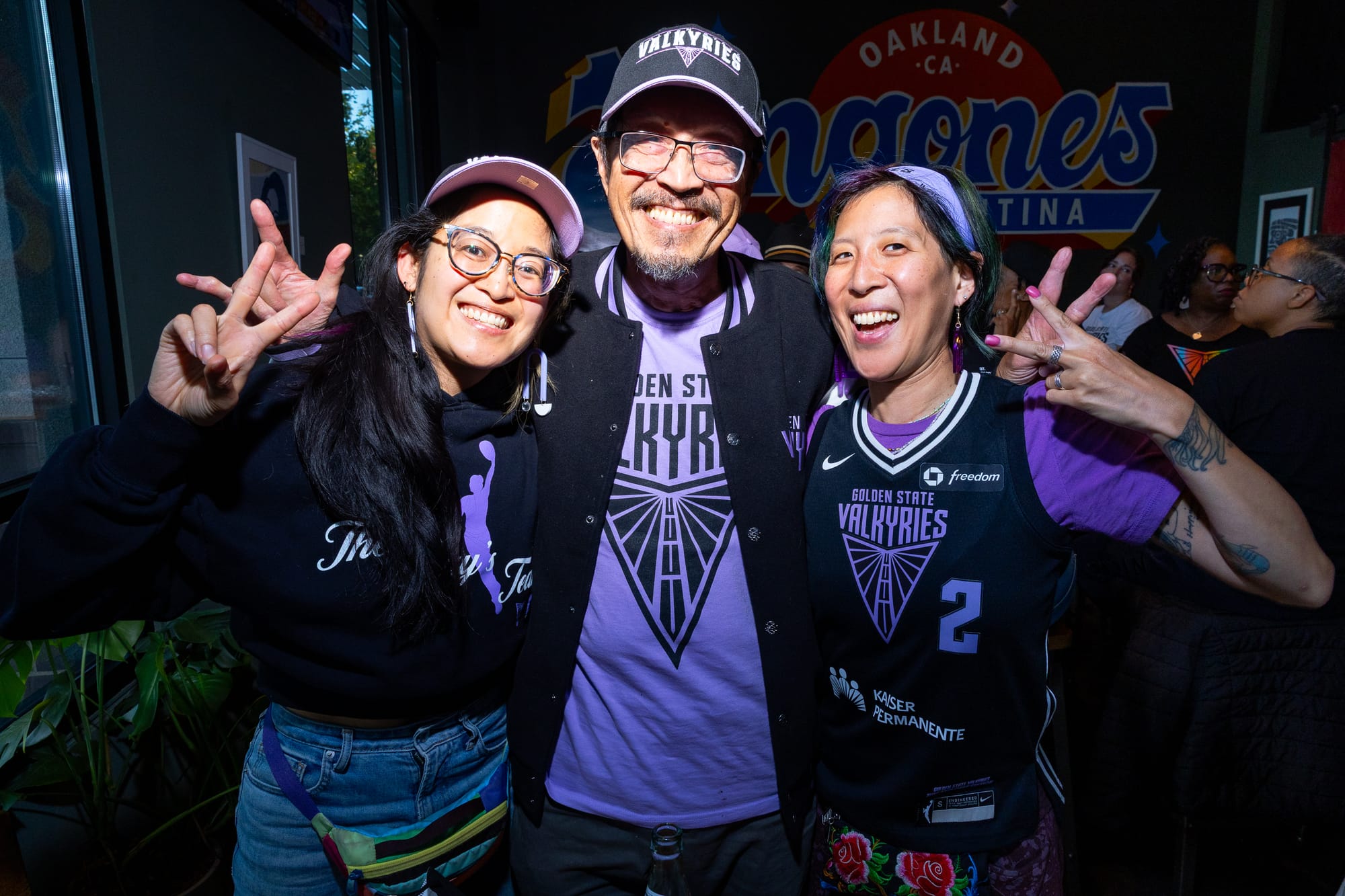
In Sideco’s view, that’s nothing to brag about: “When I hear that 7% of season ticket holders are from the Warriors, that tells me… 93% of the season ticket holders now felt marginalized by basketball before.”
My huddle with Martha and Katie was cut short by the start of the third period, and it wasn’t until back in my seat that I realized we’d forgotten to discuss the main topic at hand: Katie’s idea for a sign-making party before the last regular season home game, in support of the WNBA players’ union. Katie, who is both a lesbian and a labor organizer, won’t let the fairytale of Ballhalla obscure the true main character of the 2025 WNBA season: the collective bargaining agreement. “We support the players who are the ones creating this experience and creating the wealth,” Katie told me. “Everyone else can go to hell… They need a pension.”
Nope, WNBA players still don’t have pensions. It’s yet another way the best women’s basketball players in the world continue to earn just a fraction of what their male counterparts receive. Most obvious are the salaries, which in the WNBA start at $66,079 and are capped at $249,244. In the NBA, the max is $154,647,000 and a minimum is over $1M. That’s not even getting into the glaring questions about the fact and fiction around collective bargaining negotiations — including where the $70 million in estimated revenue from owner Joe Lacob’s first WNBA franchise actually goes.
We gathered at the tables of Harmonic Brewing, outside Chase Center, where you could see past the park and across the bay’s sun-kissed surface. Katie brought paper, and the ValQueeries supplied markers, donated by one member who’d been urging fellow queer fans to make signs supporting the players for months.
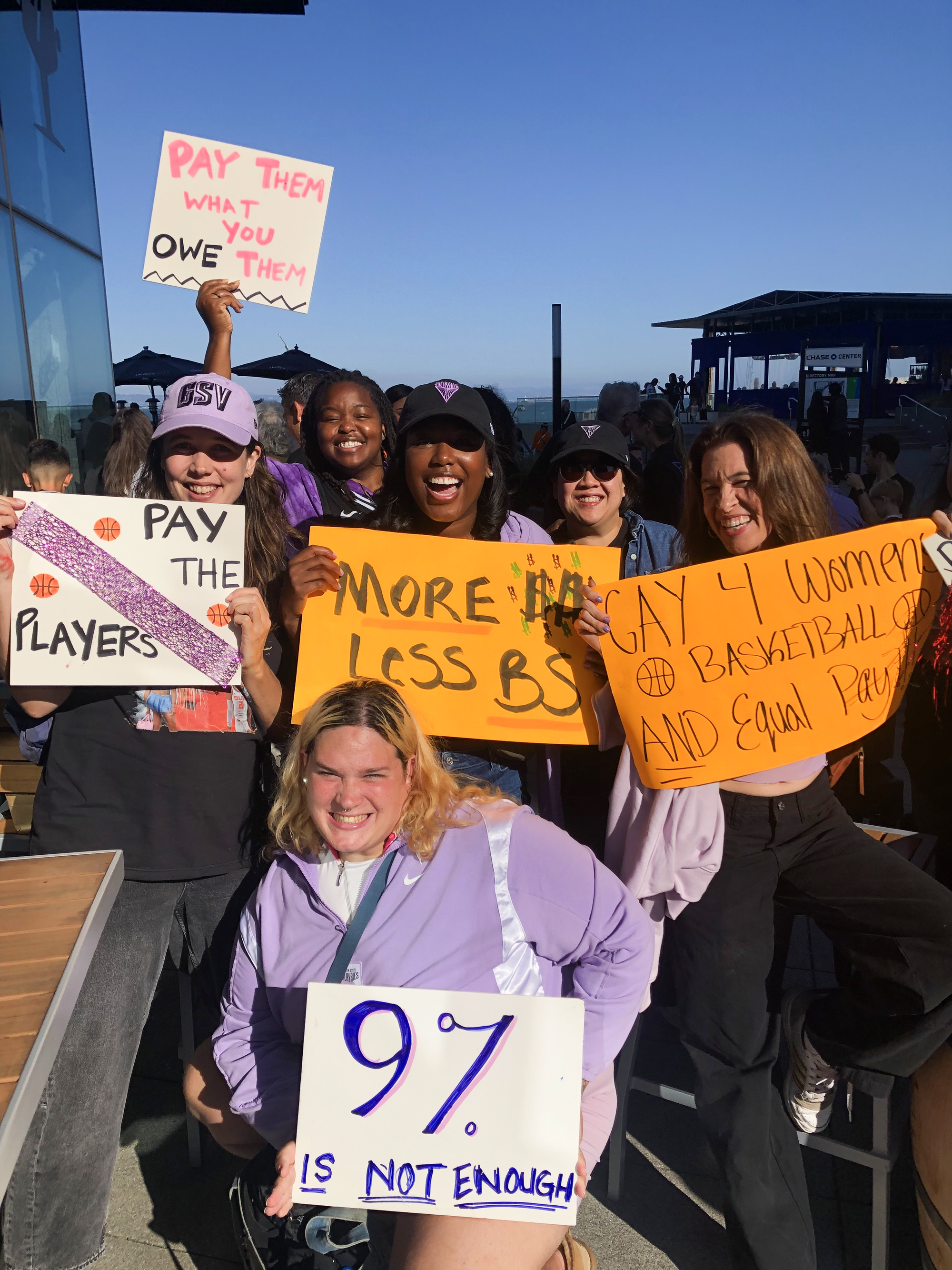
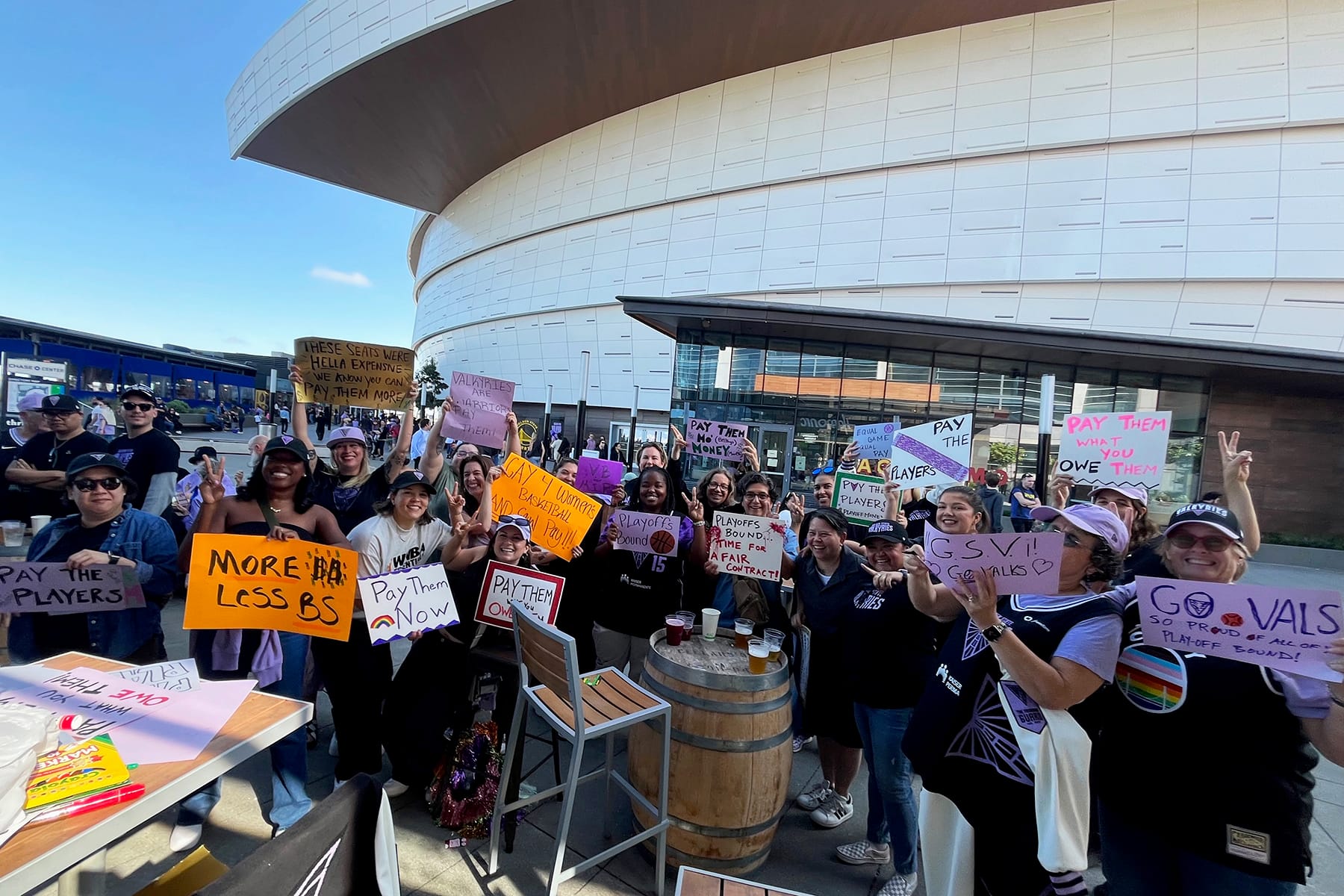
LGBTQ+ Golden State Valkyries fans and allies hold signs in support of new contracts for athletes and the WNBA’s players’ union, outside of Harmonic Brewing on Sept. 6, 2025. (Photos: courtesy of Megan Doherty-Baker/ValQueeries)
As the group grew, other fans walking by waved and pointed, like cars honking while passing a protest. It was a joyful affair: we shared drinks and brainstormed slogans (“These seats were hella expensive, we know you can pay them more”) as fans arrived wearing glitter and facepaint. A few people reported being stopped earlier in the season and told they could not bring in “political” signs. But everyone seemed determined anyway. “If you can’t get in, report back to us,” Katie was telling people, “but also, just try somewhere else. Hide it in your clothes.”
As we worked, I tried to remember the exact language of a book about women’s basketball that I read earlier this summer, written by Dr. Courtney M. Cox, that had me in tears before the end of the first chapter. Cox wrote Double Crossover over seven years, focusing on the labor of Black American players pursuing pro careers across borders and around the world.
Operating within a “discriminatory system” like the world of women’s basketball, Cox describes how one specific move becomes a metaphor for playing the game both on and off the court. The double crossover — that move where you fake going one way, then double back to the other — creates a new means of “maneuvering, wiggling in and out around defenders,” a method that allows “alternatives and possibilities cultivated by athletes aware of these constraints” to take up more space. Women’s basketball players, she argues, can even use this move to “create new forms of feminist thought.”
And I wonder, if by striving for a community that breaks expectations, that listens to players’ voices through the noise, that inscribes demands on paper tucked underneath our sweatshirts, whether queer fans aren’t stealing that move. We may already have what it takes to change direction, to create our own possibilities, to transform and maybe even liberate the game.
Editor's note: An earlier version of this article misstated the Valkyries' estimated revenue for the season. It is $70 million. The team's estimated value is $500 million.

Maya Goldberg-Safir splits her time between Oakland and Chicago, telling stories about women's basketball, including for her newsletter/blog, 'Rough Notes.'
View articles